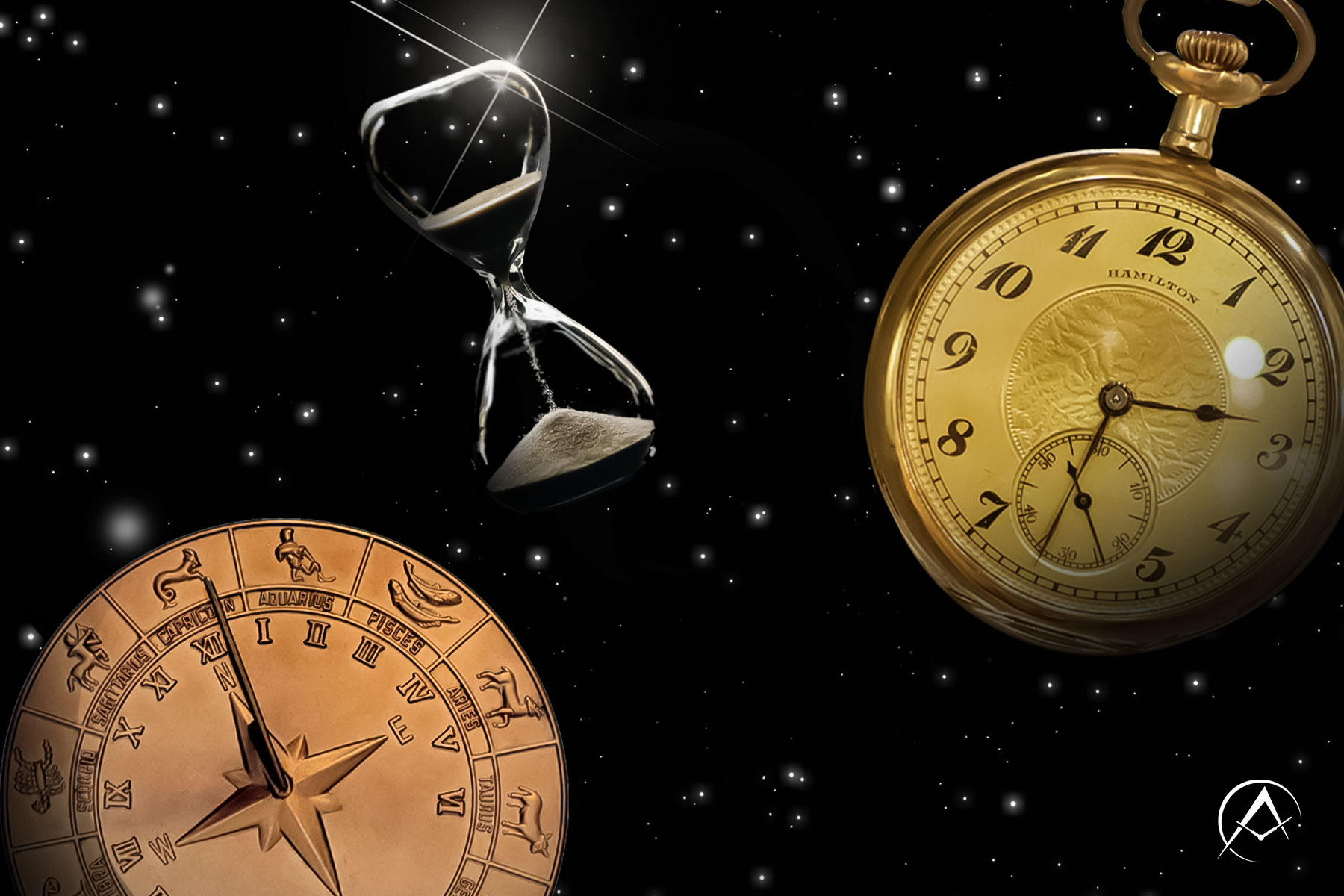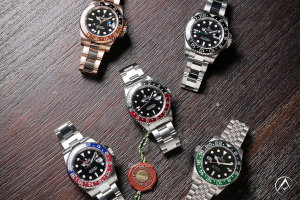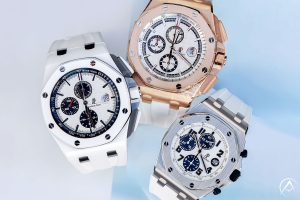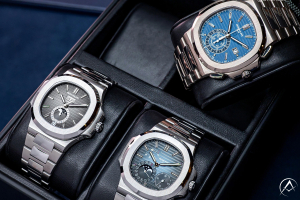
Earliest Time Tellers
Evidence suggests that people have been telling time long before they started recording it. People used sundials to measure time before they became accessories. The sundial is one of the oldest time-measuring instruments recorded in 1500 BC.
Though it was commonplace in both China and Egypt, there were major flaws with the instrument. With gaps between the sun setting and rising, there was no way of telling time at night. Due to its size, it had to stay stationary.
To fill the gap between the missing time, people experimented with different apparatuses. They burned 4-hour candles with markings at each inch to account for 20 minutes each. People also experimented with hourglasses, which preceded the water clock. The specific time it could measure depended on the quantity and coarseness of the sand, bulb size, and neck width.
While you’re probably familiar with a sundial and hourglass, the method of a water clock isn’t as readily known. “The earliest water clocks came in two types: inflow and outflow,” an article from How Do Water Clocks Work explains.
“Both designs involved two large containers. One container was filled with liquid and suspended over the second one. Water dripped through a hole in the bottom of the filled container to the bottom one.”
While they may have found the flow of the water soothing, the people craved convenience.
Mechanical, Pendulum, Cuckoo & Decimal Clocks
Mechanical clocks popped up in the 13th century during the Renaissance period. They were developed in Medieval Europe. The clock used a crown wheel escapement to control its rate and make the gear train move at regular ticks.
These clocks told time by striking bells. Henry de Vick built the most famous mechanical clock in 1360. It was the basis of improvements in timekeeping for the next 300 years.


The invention of the mainspring in the early 15th century made it possible to create small clocks for the first time. Christiaan Huygens patented the first pendulum clock in 1656. Using astronomy increased the accuracy of measuring time.
The first pendulum clocks used a verge escapement to control its rate. They required wide swings of about 100°, hence the short, light pendulums. Although his invention was the first accurate clock, it did not have a dial, nor was it portable.
In 1629, Philipp Hainhofer penned the first cuckoo clock in 1629. These beautifully crafted clocks may remind people of their grandparents’ homes. Some people associate the clocks with memories of Germany's Black Forest, where the devices originated. Farmers would craft these musical clocks to earn a living while their farms were dormant during the frigid winters.


After the French Revolution, the government assigned decimal time. Pierre Daniel Destigny in France made the decimal clock. It divided the day into 10 hours, with 100 minutes per hour and 100 seconds per minute.
In 1754, mathematician Jean le Rond d'Alembert suggested the concept of breaking the day down into multiples of 10. People didn't want to adjust to something they weren't accustomed to, regardless of the easy mathematics behind the decimal clock. (That, and replacing every clock was becoming too costly.) Decimal time stopped after just 17 months, though some used them for years afterward.


Pocket Watch
Sailors used to use an hourglass to keep track of their 4-hour shifts, or watches. (Ah, so that’s where the word comes from!)
A German locksmith named Peter Henlein invented the world’s first portable pocket-sized clock in the mid-1500s. Thus, the Swiss watch industry was born.
The first clocks were created by blacksmiths with the ability to bend and form iron. However, new materials such as brass, bronze, and silver became favorable as time went on. The minute hand wasn’t introduced until 1680.


Pocket watches like Henlein’s creations began as necklaces, as this was how Kings wore them. King Charles II popularized the waistcoat as the correct way to dress and an easy way to access the watch. The three-piece suit is still as fashionable today as it was then.
17th -century pocket watches were a great way to display wealth, as they were significant investment pieces. In the past, wealthy men hung them on a short chain. This enabled them to easily slip out of their coats. It also allowed for more protection, since the pocket watch was originally made without the glass protecting the dial.
Once watchmakers mastered the accuracy of timekeeping, they created pocket watches with features such as calendars, stopwatches, and astronomical indicators.
The first clocks were created by blacksmiths with the ability to bend and form iron. However, new materials such as brass, bronze, and silver became favorable as time went on. The minute hand wasn’t introduced until 1680.
Jewelry Ban
Stern teachings of reformist cleric John Calvin led jewelers to learn a new trade: watchmaking. Calvin fled to Geneva in the late 1500s after a Protestant uprising in France. With his ban on wearing jewelry, shops could no longer display luxury gold and diamonds.
Geneva’s goldsmiths and jewelers from France and Italy came to the rescue. As refugees as well, they helped Geneva turn to watchmaking instead. Calvin allowed watches and clocks to be made due to their necessity.
And now, people consider watches as one of the most luxurious forms of jewelry to date. That’s quite the loophole he got himself into!
The Wristwatch
Women's watches were traditionally more embellished. The women wore them as pendants or on a chatelaine, which was a short chain attached to their belts.
In 1868, Countess Koscowicz of Hungry had a bracelet watch made by well-known manufacturer Patek Philippe. The common practice of frequently checking the time with a pocket watch was becoming inconvenient.


World War 1 popularized the trench watch. The soldier created it to keep an eye on the time without having to carry around extra equipment. For an aviator or soldier to carry out their mission as planned, the wristwatch became more practically manufactured. The U.S. marketed the wristwatch to soldiers as a necessity to their uniform.
This mass production in the 19th century allowed for cheaper materials and new mechanics in winding. This decision then opened the watch industry to ordinary people, not just the rich.


Women began wearing watches in the 20th century. Men didn’t jump into the popularization of wearing the fashion around their wrists until the start of the first war. By 1916, the pocket watch fell out of fashion, and the wristwatch became the standard accessory for timekeeping.
From Necessity to Accessory
The spirit of the watch, though always changing, is still just as popular today as it was during WW1. Technology lets designers make pieces at different price points so everyone can afford them. Now, people consider it uncommon not to own one.
Throughout history, watches have played various roles in people’s outward expression of how modern, manly, feminine, or rich they are. They have been financial investments and tools of war. They serve as a reflection of the ways that clothing can shape technology and our lives.
Just like we can show off our personality in clothes, the way we accessorize helps us express ourselves as well. A luxury watch remains a timeless purchase and people often celebrate its versatility. There has been a shift in thought among young entrepreneurs making style decisions around the watch.
People don’t want to lock away antique watches; they want to enjoy their value. They need regular winding and servicing to stay in top-notch condition. Watches have become a collector’s item. They are more valuable and become a greater investment the longer you own them in good condition.
Luxury watches can be an accessory, an investment, and a statement piece. The relevance stems back to the 1960s when men bought Rolexes to acknowledge their promotions. Fast forward to today where Rolexes are symbols of those celebrating success or making savvy investments.


Time Ticking Technology
Calculator watches preceded today’s smartwatches, as did novelty watches with simple computer games. They were introduced in the late 1970s and remained popular throughout the 1980s when they created the first computer watch.
In 1994, Timex’s Datalink wrist watch could communicate wirelessly with a PC. Steve Mann designed the first Linux wrist watch in 1998.
In 1999, Samsung offered a watch phone with a full 90 minutes of talk time. From 2003 to 2010, developers created new smartwatches. New smartwatches continued to develop over the years, and then Apple introduced its first smartwatch in 2014.
Today, top manufacturers offer smartwatches, all with unique features. Technology may keep advancing, but the idea of the watch is still, as they say, timeless. Wristwatches remain valuable to collectors all around the world for their beauty and style. Fashion trends always veer towards the traditional, and the legacy of the watch remains strong.


Will the evolution of the watch be even lighter and slimmer? Will they be compatible with our hovercrafts? Avi & Co. is excited to see where the watch world will take them.

 By
By 



